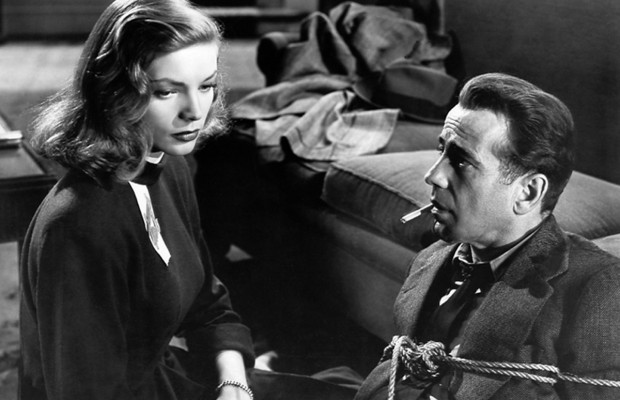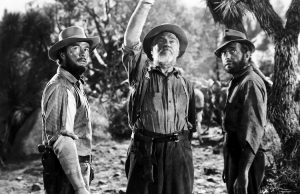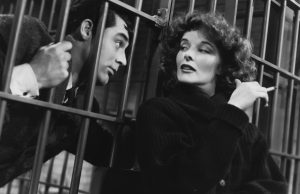The Big Sleep (1946)

Toronto Film Society presented The Big Sleep on Friday, May 11, 2012 as part of Season 65 May Festival: The Dead Men Don’t Wear Plaid Weekend.
It wasn’t too long ago that I watched this wonderful film. I wanted to pay attention to all the plot curves to see if some things really didn’t make sense. The DVD also had some very interesting features including some scenes that were deleted from the final film. Remade in 1978 with Robert Mitchum and Sarah Miles, directed by Michael Winner. – Caren Feldman
There’s plenty of boxoffice potential in “The Big Sleep.” Star names and release, combined with the sexy melodramatics of the Raymond Chandler novel, point the way to large returns. Brittle Chandler characters have been transferred to the screen with punch by Howard Hawks’ production and direction, providing full load of rough, tense action most of the way. Name of Humphrey  Bogart, coupled with Lauren Bacall, furnishes marquee voltage for customer lure.
Bogart, coupled with Lauren Bacall, furnishes marquee voltage for customer lure.
Bogart’s portrayal of Phil Marlowe, Chandler’s hard-living and loving private detective, has plenty of…down by Production Code demands. Miss Bacall comes through strongly as Vivian. Marlowe’s chief romantic interest. They make a smooth team to get over the amatory play and action in the script. Hawks has given story a staccato pace in the development, using long stretches of dialogless action and then whipping in fast talk between characters. This helps to punch home high spots of suspense, particularly in latter half of picture.
Chandler plot, scripted by William Faulkner, Leigh Brackett and Jules Furthman, deals with adventures of Bogart when he takes on a case for the eccentric Sternwood family. There are six deaths to please whodunit fans, plenty of lusty action, both romantic and physical, as Bogart matches wits with dealers in sex literature, blackmail, gambling and murder. Before he closes his case he has dodged sudden death, been unmercifully beaten, threatened, fought off mad advances of one of the Sternwood females, and fallen in love with another.
Some good scenes are tossed to others in the cast. Dorothy Malone, a bookshop proprietress, has her big moment in a sequence shot with sex implications as she goes on the make for Bogart. Martha Vickers, as the crazy Sternwood girl, does excellently by the assignment. John Ridgely makes a convincing bigtime gambler. Regis Toomey, Charles D. Brown, Bob Steele, Elisha Cook, Jr. and Louis Jean Heydt, Sonia Darrin. Joy Barlowe and Trevor Bardette are among others showing up well.
Low-key lighting and lensing by Sid Hickox help to further the mood, and other production appurtenances have been well valued by Hawks.
VARIETY, Brog., August 10, 1946
THE BIG SLEEP, screen play by William Faulkner and Leigh Brackett, based on the novel by Raymond Chandler; directed and produced by Howard Hawks at Warner Brothers. At the Strand.
If somebody had only told us—the script-writers, preferably—just what it is that happens in the Warners’ and Howard Hawks’ “The Big Sleep,” we might be able to give you a more explicit and  favorable report on this over-age melodrama which came yesterday to the Strand. But with only the foggiest notion of who does what to whom—and we watched it with closest attention—we must be frankly disappointing about it.
favorable report on this over-age melodrama which came yesterday to the Strand. But with only the foggiest notion of who does what to whom—and we watched it with closest attention—we must be frankly disappointing about it.
For “The Big Sleep” is one of those pictures in which so many cryptic things occur amid so much involved and devious plotting that the mind becomes utterly confused. And, to make it more aggravating, the brilliant detective in the case is continuously making shrewd deductions which he stubbornly keeps to himself. What with two interlocking mysteries and a great many characters involved, the complex of blackmail and murder soon becomes a web of utter bafflement. Unfortunately, the cunning script-writers have done little to clear it at the end.
This is a frequent failing in films made from Raymond Chandler’s books, as this one is; and if you haven’t read the original, as we haven’t, you are stuck. It is something about a detective who undertakes a job of private and perilous sleuthing for a decadent millionaire, mainly to save the old man’s daughters from some blackmailers and bums. And since quite obviously the daughters are bums, too, it has a not very lofty moral tone.
Much of the terseness and toughness of Mr. Chandler’s style has been caught in the movement and dialogue of William Faulkner’s and Leigh Brackett’s script. And Mr. Hawks, who produced and directed, has kept the action racy and raw. Everyone in the story, except the old father, seem to carry guns, which they use at one time or another  with a great deal of flourish and éclat. And fists are frequently unlimbered, just to vary the violence. Students of underworld minutiae will find plenty of it here.
with a great deal of flourish and éclat. And fists are frequently unlimbered, just to vary the violence. Students of underworld minutiae will find plenty of it here.
Through it all, Humphrey Bogart stalks his cold and laconic way as the resolute private detective who has a mindéand a bodyémade of steel. And Lauren Bacall (Mrs. Bogart) plays the older of the daughters languidly. (Miss Bacall is a dangerous looking female, but she still hasn’t learned to act.) A dozen or so other actors play various tramps and tough guys acidly, and the whole thing comes off a poisonous picture lasting a few minutes shy of two hours.
But, for all that, it’s likely to leave you confused and dissatisfied. And, by the way, would somebody also tell us the meaning of that title, “The Big Sleep.”
On the stage at the Strand are Bob Crosby and his band, the Town Criers, Don Cummings and the Dunhills.
NEW YORK TIMES, by Bosley Crowther, August 24, 1946
Notes compiled by Caren Feldman









Leave a Reply